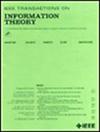Electromagnetic Information Theory-Based Statistical Channel Model for Improved Channel Estimation
IF 2.2
3区 计算机科学
Q3 COMPUTER SCIENCE, INFORMATION SYSTEMS
引用次数: 0
Abstract
Electromagnetic information theory (EIT) is an emerging interdisciplinary subject that integrates classical Maxwell electromagnetics and Shannon information theory. The goal of EIT is to uncover the information transmission mechanisms from an electromagnetic (EM) perspective in wireless systems. Existing works on EIT are mainly focused on the analysis of EM channel characteristics, degrees-of-freedom, and system capacity. However, these works do not clarify how to integrate EIT knowledge into the design and optimization of wireless systems. To fill in this gap, in this paper, we propose an EIT-based statistical channel model with simplified parameterization. Thanks to the simplified closed-form expression of the EMCF, it can be readily applied to various channel modeling and inference tasks. Specifically, by averaging the solutions of Maxwell’s equations over a tunable von Mises distribution, we obtain a spatio-temporal correlation function (STCF) model of the EM channel, which we name as the EMCF. Furthermore, by tuning the parameters of the EMCF, we propose an EIT-based covariance estimator (EIT-Cov) to accurately capture the channel covariance. Since classical MMSE estimators can exploit prior information contained in the channel covariance matrix, we further propose the EIT-MMSE channel estimator by substituting EMCF for the covariance matrix. Simulation results show that both the proposed EIT-Cov covariance estimator and the EIT-MMSE channel estimator outperform their baseline algorithms, thus proving that EIT is beneficial to wireless communication systems.求助全文
约1分钟内获得全文
求助全文
来源期刊

IEEE Transactions on Information Theory
工程技术-工程:电子与电气
CiteScore
5.70
自引率
20.00%
发文量
514
审稿时长
12 months
期刊介绍:
The IEEE Transactions on Information Theory is a journal that publishes theoretical and experimental papers concerned with the transmission, processing, and utilization of information. The boundaries of acceptable subject matter are intentionally not sharply delimited. Rather, it is hoped that as the focus of research activity changes, a flexible policy will permit this Transactions to follow suit. Current appropriate topics are best reflected by recent Tables of Contents; they are summarized in the titles of editorial areas that appear on the inside front cover.
 求助内容:
求助内容: 应助结果提醒方式:
应助结果提醒方式:


